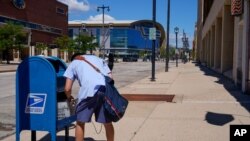ສານສູງສຸດຂອງສະຫະລັດໄດ້ຕັດສິນໃຈວັນຈັນວານນີ້ວ່າ ພວກຜູ້ມີສິດປ່ອນບັດໃນລັດວິສຄອນຊິນ ຕ້ອງໄດ້ສົ່ງບັດຂອງເຂົາເຈົ້າໄປໃຫ້ເຈົ້າໜ້າທີ່ເລືອກຕັ້ງກ່ອນເວລາທີ່ໜ່ວຍປ່ອນບັດຕ່າງໆອັດລົງໃນວັນທີ 3 ພະຈິກ ເພື່ອວ່າບັດເຫຼົ່ານັ້ນຈະໄດ້ຖືກນັບ.
ສານສູງສຸດເຫັນພ້ອມກັບພັກຣີພັບບລີກັນ ທີ່ໄດ້ທ້າທາຍຕໍ່ການຕັດສິນການໜ້ານີ້ຂອງຜູ້ພິພາກສາສານຊັ້ນຕົ້ນ ທີ່ໄດ້ອະນຸຍາດຕໍ່ເສັ້ນຕາຍ ໃຫ້ຮັບເອົາບັດໃດໆກໍຕາມທີ່ຕີກາໄປສະນີໃນວັນທີ 3 ພະຈິກ ແຕ່ໄປຮອດເຈົ້າໜ້າທີ່ເລືອກຕັ້ງພາຍໃນວັນທີ 9 ພະຈິກ.
ກຳນົດເສັ້ນຕາຍກ່ຽວກັບເລື້ອງການສົ່ງບັດແມ່ນແຕກຕ່າງກັນໃນແຕ່ລະລັດແລະການທ້າທາຍທາງກົດໝາຍ ໄດ້ມີຂຶ້ື້ນໃນໄລຍະສອງສາມອາທິດທີ່ຜ່ານມານີ້ ຊຶ່ງໂດຍທົ່ວໄປແລ້ວ ສານໃຫ້ການສະໜັບສະໜຸນກົດລະບຽບທີ່ມີຢູ່ແລ້ວໂດຍສະມາຊິກສະພາປະຈຳລັດ ຫຼືເຈົ້າໜ້າທີ່ເລືອກຕັ້ງ.
ຜູ້ພິພາກສານິລ ກໍຊັສ (Neil Gorsuch) ຂຽນລົງໃນບົດຄວາມເຫັນຂອງການຕັດສິນຄັ້ງນີ້ ໂດຍກ່າວວ່າ “ບໍ່ມີຜູ້ໃດສົງໄສທີ່ວ່າ ການຈັດການເລືອກຕັ້ງແຫ່ງຊາດທ່າມກາງທີ່ມີໂຣກລະບາດ ແມ່ນເປັນບັນຫາທ້າທາຍທີ່ສຳຄັນ. ແຕ່ບໍ່ມີສິ່ງໃດໝາຍຄວາມວ່າ ຜູ້ພິພາກສາຄົນໃດຄົນນຶ່ງອາດຕັດສິນດ້ວຍກົດລະບຽບຂອງເຂົາເຈົ້າເອງ ແທນກົດລະບຽບທີ່ຜູ້ແທນຂອງປະຊາຊົນໄດ້ຮັບຮອງເອົານັ້ນ.”
ສະມາຊິກຂອງພັກຣີພັບບລີກັນ ໃນຫຼາຍໆກໍລະນີໄດ້ໂຕ້ຖຽງວ່າ ມີເວລາພຽງພໍຢູ່ສຳລັບຜູ້ປ່ອນບັດທີ່ຈະສົ່ງບັດຂອງເຂົາເຈົ້າ ໃຫ້ໄປຮອດພາຍໃນວັນທີ 3 ພະຈິິກໃນຂະນະທີ່ພັກເດໂມແຄຣັດຖຽງວ່າ ການຕໍ່ເວລາແມ່ນມີຄວາມຈຳເປັນ ຍ້ອນມີຜູ້ປ່ອນບັດທາງໄປສະນີຫຼາຍເປັນປະຫວັດການ ເພື່ອຫລີິກລ່ຽງຕໍ່ການໄປເຕົ້າໂຮມກັນຢູ່ໜ່ວຍປ່ອນບັດຕ່າງໆໃນວັນເລືອກຕັ້ງຍ້ອນການລະບາດຂອງໄວຣັສໂຄໂຣນາ.
ຜູ້ພິພາກສາອີລີນາ ກາແກນ (Elena Kagan) ນຶ່ງໃນຜູ້ພິພາກສາຫົວເສລີ 3 ຄົນໃນສານສູງສຸດ ໄດ້ຄັດຄ້ານດ້ວຍຄະແນນສຽງ 5 ຕໍ່ 3 ຂຽນລົງວ່າ “ການຕັດສິນດັ່ງກ່າວຈະຖອນສິດ ຂອງບັນດາຜູ້ມີສິດປ່ອນບັດທີ່ມີຄວາມຮັບຜິດຊອບເປັນຈຳນວນຫຼວງຫຼາຍ ທ່າມກາງສະພາບການ ທີ່ເປັນອັນຕະລາຍ ໃນການລະ ບາດຂອງໂຣກລະບາດຮ້າຍແຮງ.”
ຄະນະກຳມາທິການເລືອກຕັ້ງຂອງລັດວິສຄອນຊິນ ລາຍງານໃນວັນຈັນວານນີ້ວ່າ ມີ 1 ລ້ານ 7 ແສນຄົນ ໄດ້ຂໍປ່ອນບັດລ່ວງໜ້າ ແລະ 1 ລ້ານ 3 ແສນ 4 ໝື່ນຄົນ ແມ່ນໄດ້ປ່ອນບັດແຕ່ຫົວທີ ຫຼືບໍ່ກໍປ່ອນບັດທາງໄປສະນີແລ້ວ.
The U.S. Supreme Court ruled Monday that voters in the U.S. state of Wisconsin need to return their ballots to election officials by the time polls close on November 3 in order to be counted.
The court sided with Republicans who challenged an earlier decision by a lower court judge to extend the deadline to accept any ballots that were postmarked by November 3 but arrived by November 9.
Ballot deadlines vary by state, and as legal challenges have played out in recent weeks, the courts have generally supported rules put in place by state legislatures or election officials.
“No one doubts that conducting a national election amid a pandemic poses serious challenges,” Justice Neil Gorsuch wrote in a concurring opinion. “But none of that means individual judges may improvise with their own election rules in place of those the people’s representatives have adopted.”.
Republicans in multiple cases have argued there is enough time for voters to return their ballots by November 3, while Democrats argued extensions are necessary with historic numbers of people casting mail-in ballots in order to avoid gathering at polling sites on election day due to the coronavirus pandemic.
Justice Elena Kagan, one of three liberals on the Supreme Court who dissented in the 5-3 decision, wrote that the ruling "will disenfranchise large numbers of responsible voters in the midst of hazardous pandemic conditions."
The Wisconsin Elections Commission reported Monday that 1.7 million people had requested to vote by absentee ballot, and that 1.34 million had either cast a ballot by mail or voted absentee in person.
Nationwide, more than 64 million people had either cast mail-in ballots or voted early in person as of Monday night, according to the U.S. Elections Project.
About 20 of the 50 U.S. states currently allow ballots to come in after Election Day as long as they are postmarked by November 3.











